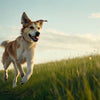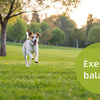Can Dogs Exercise After Eating? Understanding the Risks and Best Practices
- Houndsy
Table of Contents
- Introduction
- Understanding Canine Digestion
- Risks of Exercising After Eating
- How Long Should You Wait to Exercise?
- Alternatives to Post-Meal Exercise
- Managing Feeding Routines for Optimal Health
- Houndsy Kibble Dispenser: Elevating the Feeding Experience
- Conclusion
- FAQ
Introduction
As loving pet owners, we often find ourselves grappling with various questions about our furry friends’ health and well-being. One particularly pressing concern many of us have is whether dogs can exercise after eating. It’s a common scenario: you’ve just served your dog a delicious meal, and moments later, they’re bouncing around the house, eager for a walk or playtime. But before we throw on the leash and head out, let’s take a moment to consider the implications of exercising immediately after eating.
Research suggests that engaging in vigorous activity right after a meal can pose serious risks to our dogs, including the dreaded bloat, or Gastric Dilatation-Volvulus (GDV). This condition can be life-threatening and is particularly prevalent in certain breeds. In this blog post, we’ll explore the relationship between feeding and exercise, the risks involved, and best practices to ensure our dogs remain healthy and happy. By the end, you’ll have a comprehensive understanding of how to balance your dog’s exercise routine with their feeding schedule, along with some insights into how our Houndsy Kibble Dispenser can enhance your dog-feeding experience.
Understanding Canine Digestion
Before diving into the specifics of post-meal exercise, it’s essential to grasp how a dog’s digestive system works. When a dog eats, food is chewed and swallowed, then transported to the stomach, where it’s mixed with gastric juices. This process creates a semi-liquid mixture that moves into the intestines, where nutrients are absorbed.
The Digestive Process
- Ingestion: Dogs use their teeth to chew food, which is then swallowed.
- Stomach Processing: In the stomach, food is broken down by stomach acids and enzymes.
- Nutrient Absorption: The mixture moves to the intestines, where nutrients are absorbed into the bloodstream.
- Elimination: Unused food is excreted as waste.
The entire digestive process can take anywhere from 6 to 10 hours, depending on various factors, including the type of food consumed.
Risks of Exercising After Eating
Engaging in physical activities immediately after meals can disrupt this process and lead to serious health risks for dogs. Here are the primary concerns:
Bloat and GDV
Bloat occurs when gas builds up in the stomach, causing it to expand. GDV is a more severe condition where the stomach twists, obstructing blood flow and potentially leading to shock or death if not treated promptly.
- At Risk Breeds: Larger and deep-chested breeds, such as Great Danes, German Shepherds, and Boxers, are particularly susceptible to these conditions.
- Symptoms: Signs of bloat include restlessness, excessive drooling, an enlarged abdomen, and attempts to vomit without success. If your dog exhibits these symptoms, seek emergency veterinary care immediately.
Digestive Discomfort
Even if bloat does not occur, exercising after eating can cause general digestive upset, leading to issues like:
- Vomiting: This is often a response to the stomach being jostled during vigorous activity.
- Diarrhea: Rapid movement can disrupt normal digestive processes, leading to loose stools.
- Abdominal Pain: Exercise diverts blood flow away from the digestive organs, potentially causing cramps or discomfort.
How Long Should You Wait to Exercise?
To minimize the risks associated with exercising after meals, it’s generally recommended to wait a specific amount of time based on the size of the meal consumed:
- Small Snack: Wait at least 30 minutes.
- Small Meal: Wait at least 1 hour.
- Medium/Large Meal: Wait 2 to 3 hours.
These timeframes allow your dog’s body to begin digesting the food properly, reducing the chances of bloat and other digestive issues.
Alternatives to Post-Meal Exercise
While it’s important to avoid vigorous activity right after your dog eats, that doesn’t mean they should be bored! Here are some alternatives:
Gentle Activities
- Short, Calm Walks: A leisurely stroll can aid digestion without putting too much strain on your dog’s stomach.
- Mental Stimulation: Engage your dog with puzzle toys or training sessions that require less physical exertion.
Creating a Relaxing Environment
After meals, consider creating a cozy space for your dog to relax. Providing a comfortable bed or a chew toy can help them unwind while their food digests.
Managing Feeding Routines for Optimal Health
Feeding your dog properly can significantly reduce the risks associated with exercise after meals. Here are some strategies:
Smaller, More Frequent Meals
Instead of one or two large meals, consider feeding your dog smaller portions throughout the day. This approach can help minimize the risk of bloat and make digestion easier.
Monitor Water Intake
Encourage your dog to drink water in moderation before and after meals. Rapid water consumption can introduce excess air into the stomach, increasing the likelihood of bloat.
Houndsy Kibble Dispenser: Elevating the Feeding Experience
At Houndsy, we understand the importance of a seamless feeding routine. Our flagship product, the Houndsy Kibble Dispenser, exemplifies our commitment to design excellence and pet well-being.
Features of the Houndsy Kibble Dispenser
- Perfect Portion Control: Our dispenser ensures your dog receives the right amount of food every time, minimizing the risk of overeating.
- Ergonomic Design: With a convenient crank at standing height, feeding becomes an effortless part of your day, eliminating the need for awkward bending.
- Large Storage Capacity: With a capacity of 25–30 lbs, it keeps kibble fresh in a BPA-free liner while seamlessly fitting into your home decor.
- Auto-Locking Mechanism: This feature prevents accidental dispensing by curious pets or toddlers, ensuring a safe feeding environment.
Investing in the Houndsy Kibble Dispenser not only enhances your pet’s feeding routine, but it also contributes to their overall health and happiness. To explore more about this innovative product, click here.
Conclusion
Understanding the relationship between feeding and exercise is crucial for maintaining your dog’s health. By waiting appropriately after meals before engaging in physical activity, you can significantly reduce the risks of bloat and other digestive issues. Remember, each dog is unique, and it’s essential to observe their behavior and adjust routines accordingly.
As you consider your dog’s feeding and exercise schedule, remember that our Houndsy Kibble Dispenser is designed to make the feeding process not only convenient but also enjoyable for both you and your pet. With our commitment to quality and design excellence, we strive to enhance your daily pet care experience.
FAQ
Q: Can I walk my dog immediately after eating?
A: It’s best to wait at least 1 to 2 hours after a meal before taking your dog for a walk to avoid the risk of bloat and other digestive issues.
Q: What are the signs of bloat in dogs?
A: Symptoms of bloat include restlessness, drooling, a swollen abdomen, and attempts to vomit without success. If you notice these signs, seek veterinary care immediately.
Q: How can I prevent my dog from getting bloat?
A: To prevent bloat, feed smaller, more frequent meals, monitor water intake, and avoid vigorous exercise shortly after eating.
Q: Is it safe to feed my dog before a walk?
A: It’s generally recommended to wait at least 30 minutes after a small snack and 1 to 2 hours after a larger meal before exercising your dog.
Q: How can the Houndsy Kibble Dispenser help with my pet’s feeding routine?
A: The Houndsy Kibble Dispenser ensures perfect portion control, reduces mess, and provides an ergonomic feeding experience, making mealtime easier and more enjoyable for both you and your dog.
By adopting these practices and utilizing the Houndsy Kibble Dispenser, we can all contribute to a healthier, happier life for our beloved pets.












